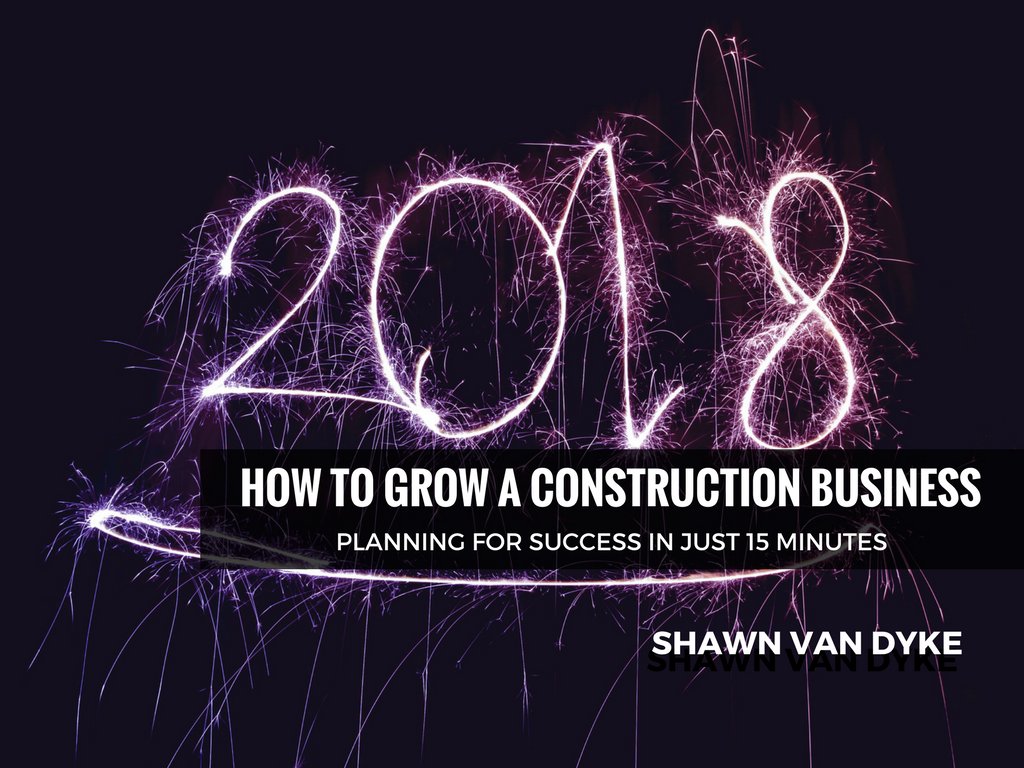Built to Build: Blog
HOW TO GROW A CONSTRUCTION BUSINESS – YEAR END PLANNING

Developing a strategy for how to grow your construction business in the New Year requires planning.
In fact, the act of planning is more important than the plan itself.
The plans you make today are for a world that will change tomorrow. Knowing how to plan will ensure that you can adapt today’s plan to tomorrow’s reality.
Dwight D. Eisenhower is quoted as saying:
“In preparing for battle I have always found that plans are useless, but planning is indispensable.”
Year-end planning forces you to think about, evaluate, and prioritize the steps that will meet the goals for your construction business in the coming year.
HOW TO GROW A CONSTRUCTION BUSINESS – YEAR-END PLANNING
If you have never made a year-end plan for your construction business based on the previous year’s data, then you might be at a loss as to where to start.
Here’s a 15-minute planning exercise to grow your construction business in the New Year.*
*NOTE: The numbers used in this exercise are simple in nature and should be readily available even if your books are a mess. A deeper financial analysis should be performed at the time that you have more data available, but this is a good place to start.
Step 1 – Determine Your Target Revenue
Slow, purposeful growth is profitable, sustainable growth.
If something grows by 15% each year, then that thing will double in size in 5 years.
(See the chart below for a construction business with a Current Year Revenue of $750,000.)
Five years is a lifetime if you are in Silicon Valley. Most construction companies are small businesses with owner-operators not venture capital backed startups.
Fifteen percent growth year-over-year for five years demonstrates a healthy, sustainable construction business.
TARGET REVENUE = CURRENT YEAR REVENUE x 1.15
Based on the table above, the TARGET REVENUE for this construction business is:
TARGET REVENUE = $750,000 x 1.15% = $862,500*
*Note: Increasing your Current Revenue to your Target Revenue does not mean that you will be more profitable. You will need to perform a deeper financial analysis of your Net Profits. This step is to provide you with a general target revenue.
Step 2. Determine your Revenue Per Employee
You achieved your Current Revenue by putting work in place, and that work was performed by your employees.
You can now determine the production metric – Revenue Per Employee (RPE).
(See this article for more information on the Revenue Per Employee metric.)
RPE = CURRENT REVENUE / TOTAL NUMBER OF EMPLOYEES
Example:
Let’s assume that the company above had 4 production employees (employees in the field putting work in place).
The RPE for the CURRENT YEAR is:
CURRENT YEAR RPE = $750,000 / 4 Field Employees = $187,500
Step 3. Determine the Number of Field Employees Needed to Hit Target Revenue
Now that you know your Current Year RPE, you can determine how many employees you need to achieve your Target Revenue in the new year.
# of Field Employees Needed = TARGET REVENUE / CURRENT RPE
# of Field Employees Needed = $862,500 / $187,500 = 4.6
Now it is very hard to hire 60% (0.6) of a person. You probably have to hire a whole person, so your projected number of Field Employees would round up to 5.
But at your CURRENT RPE, your TARGET REVENUE would also need to increase to account for the additional whole person.
Your ADJUSTED TARGET REVENUE is:
ADJUSTED TARGET REVENUE = CURRENT RPE x # of Field Employees
ADJUSTED TARGET REVENUE = $187,500 x 5 = $937,500
But before you decide to run out and hire a person and increase your sales volume, you might be able to reach a higher RPE by employing these two tactics.
Step 4. Increase Your RPE Through Performance and Price
BE MORE EFFICIENT
If you increase the efficiency of your field employees, then you increase your RPE.
For example:
Let’s say that you increase your field employees’ efficiency by 7%.
Your RPE would go from $187,500 to $200,625.
ADJUSTED RPE = $187,500 x 1.07% = $200,625
How do you raise the efficiency by 7%?
One way to do this is to break this percentage down into an actionable item that can be easily performed by your employees.
7% of an hour is only 4.2 minutes.
If you ask your employees to come up with ways in which they can save 4.2 minutes per hour or about 30 minutes per day, then my guess is that you will be able to increase your efficiency by approximately 7%.
This is not impossible when you break it down like this.
RAISE YOUR PRICE
Another way to increase the RPE is to charge your customers more money for the same amount of work.
If you increase your prices, then you will increase the RPE.
For example:
Using the RPE we just calculated above, your RPE would go from $200,625 to $220,688.
$200,625 x 1.10% = $220,688
Step 5. Determine Your Optimal Number of Employees
Using the RPE calculated above, we can determine the number of employees needed to hit the Target Revenue.
# of Field Employees Needed = TARGET REVENUE / ADJUSTED RPE
# of Field Employees Needed = $862,500 / $220,688 = 3.9
Based on the Optimal Number of Employees and the Adjusted RPE, you may be able to make the gain in Target Revenue without adding an employee.
Step 6. Determine Your Quarterly Goals
Once the Target Revenue has been set, we can determine not only the revenue we need to produce each quarter but the RPE per quarter for each employee.
Quarterly Revenue = Target Revenue / 4 quarters
Quarterly Revenue = $862,500 / 4 quarters = $215,625
Quarterly RPE = $215,625 / 4 employees = $53,906
Step 7. Evaluate Your QRT 1 Schedule
Now, look at the amount of work on the books for the first quarter and total the amount of work that can be put in place, invoiced, and collected.
Let’s assume that you have $225,000 worth of work booked for the first quarter of the new year.
You can do a quick Production Capacity check to verify that you can meet that goal.
For example:
We know that your Quarterly RPE is $53,906.
The work booked for this quarter is $225,000.
Now you can determine the number of employees it will take to get the work completed:
# of Employees Needed = $ of Work Booked in QRT 1 / Quarterly RPE
# of Employees Needed = $225,000 / $53,906 = 4.17
This quick calculation will show you that you need 17% more production in the first quarter to meet the production on the books.
If you hire someone in the first quarter, then the Target Revenue for the year will be based on 5 employees working all year at an RPE of $220,688 (calculated in Step # 4 above).
The new Target Revenue would be:
5 employees x $220,688 = $1,110,440.
If you decide that you will make up the additional 17% by working overtime rather than hiring another employee, then you can plan your schedule accordingly.
On average your employees will be working 46.8 hours each week, or 40 hours per week x 1.17%.
Planning your overtime work in the short term (3 months) may be more cost-effective than hiring a new employee (12 months).
Step 8. Determine what actions must be taken in QRT 1 to succeed in QRT 2
Going through this planning process will give you the information you need to make decisions in a timely manner.
Now you can set sales, training, production, and hiring goals to meet the revenue projections you just established, and you can go forward into the new year with confidence that you are working a plan.
Step 9. Publish your goals
You now have the plan. Publish the plan to your team and talk about the decisions that went into the planning.
A study conducted by Dr. Gail Matthews shows that people who write down their goals and share them with others are almost twice as likely to accomplish those goals than people who don’t write them down.
SUMMARY
You have completed the most important task for your construction business – planning for success.
Even if your books are a mess, you probably know your Total Revenue, and you can calculate your RPE.
This planning exercise is not designed to provide you with a detailed financial analysis. That will take more data and tracking.
Use this information to develop a plan for the new year.
When the plan is in place, then you can start analyzing other things in your business like Costs, Expenses, and Net Profits.
Before you know it, you’ll have a more in-depth view of your construction business and the factors that directly affect your bottom line.
But you don’t need to wait for more information or a deep analysis to set goals and lay out a plan for the new year.
Use the 9 steps listed above and make a plan for the new year. Break the plan down into smaller goals, and publish the metrics as the weeks and months go by.
Benjamin Franklin is credited with saying, “If you fail to plan, you are planning to fail.”
Don’t fail. Do the planning. Work the plan. Grow your construction business.
Happy New Year.
If you want to streamline your construction business and DOUBLE your profits next month…


